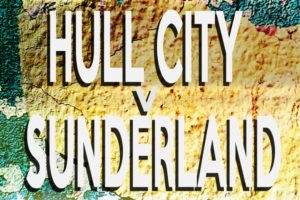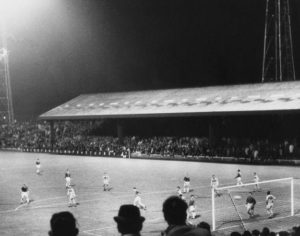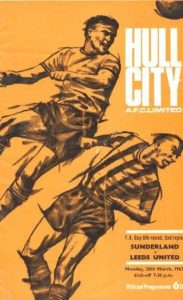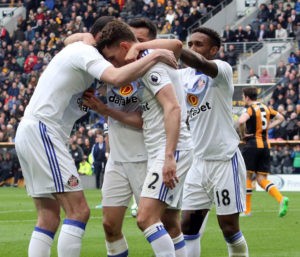Malcolm Dawson writes……..here in the latest instalment of his series in which, prior to an away game, he recalls the first visit he made to the home(s) of our upcoming opponents, strong Pete Sixsmith looks back on previous outings to the UK City of Culture that is Kingston upon Hull.
 TFTEISYG HULL CITY.
TFTEISYG HULL CITY.
One of the big disappointments of Hull City’s first promotion to the Premier League was that they were no longer the answer to the question “Which is the biggest city in England never to have had a team in the top division?” although they are the answer to the question “Which is the only club in the 92 where you cannot colour in any of the letters!?”
Along with ourselves they can probably lay claim to the title of “most working class city ever to have played in the Premier League” (with Bournemouth and Norwich not far behind) and they can certainly take the title of “senior club with the best suspension bridge nearby” and “club with the most supporters who drop the letter h the most.” For the Tigers fans live in ‘Ull on the banks of the ’Umber and some of them live in ‘Essle or ‘Altemprice, except they’re not very keen on saying t’s either. So, for their followers, it’s ‘Ull Ci-i.”
They now play in the well-appointed KCOM Stadium, built in 2002 on the site of the cricket ground at Anlaby Circle and a stone’s throw away from City’s first ground at Anlaby Road. The finance for it came when the council sold its share in the local telecommunications company – the one that was never part of Post Office Telecoms or BT and gave Hull its distinctive cream phone boxes. They built a stadium that would be shared by Hull City (then languishing in the basement division and just out of administration) and Hull FC, one of the two senior rugby league clubs who represent the city. Tradition dictates that if you are born west of the River Hull you follow FC, if you are born east of the river, you are a Hull KR supporter.
I first ticked off the KC (as it was then) in December 2003. We had a Monday night game at Coventry (drew 1-1 – Stewart Downing scoring) so I took the train via Doncaster and Goole for City’s clash with Bury.
The train ride to Hull is an interesting one. You pass under the Humber Bridge (known by locals as “The Bridge to Nowhere”), go past the KCOM and arrive at Hull Paragon station. Like many of its kind, Paragon is a shadow of its former self and the windows where you could book through tickets to Oslo, Hamburg, Rotterdam and Lubeck are long gone.
Much of the city centre was destroyed by enemy bombing during the Second World War. After London, Hull was the most bombed city in the UK, partly due to the fishing fleet and engineering factories, partly due to the fact that assorted Heinkels and Dorniers wanted to ship their bombs before they flew back to their bases. Consequently, they destroyed the heart of the old Victorian city.
There was a major rebuild in the post-war period and nowadays it looks a little dated in places but the City of Culture tag has led to more visitors and a discernible pride in a city that has much to be proud of. After all, it gave the world Tom Courtney and Maureen Lipman, William Wilberforce and Amy Johnson and Clive Sullivan, the first black man ever to captain a British national team when he led the Great Britain rugby league team to victory in the 1972 World Cup – long before the posh boys had ever even thought of having one.

Before they moved to the KCOM, City played at Boothferry Park, a relatively new ground opened in 1946 and a bit of a stunner in its early days. It had 6,000 seats (more than most clubs), its own railway station which I used once and six floodlight pylons, three of which were very, very tall. They were part of the Hull renaissance of the 1960s when the Needler family used the profits from their business to bankroll the club. Serious money was spent on Ken Wagstaff, Ian Butler and Ken Houghton and along with the formidable Chris Chilton they made Division Two (now the Championship for our younger reader) for the first time in a long time.
It was during that period that I made my first visit to Boothferry Park. Not to watch Hull City but to see the third game of an engrossing FA Cup Fifth Round tie between Sunderland and Leeds United. It was a game that Sunderland supporters will remember until their dying day.
There was no love lost between the two clubs. Leeds were near the top of the league and we were on a good run and went into this game after we had completed the second leg of a 3-0 double over Our Friends From The North.
We squeezed another 5,000 into Roker for the cup game as 55,763 paid to watch a cup tie that was spoiled by a strong wind – as was often the case at our old home. Neil Martin gave us the lead, Jack Charlton levelled ten minutes later and Bobby Kerr broke his leg in a challenge with Norman Hunter. Ironically, it was a needless foul by Kerr on the Leeds hard man that caused the injury.
We lined up thus:
Montgomery; Irwin, Ashurst; Todd, Kinnell, Baxter; Kerr, O’Hare, Martin, Herd, Mulhall sub; Gauden
Dorty Leeds like this:
Sprake; Reaney, Bell; Bremner, Charlton, Hunter; Madeley, Belfitt, Greenhoff, Giles, Lorimer sub; Bates
You can see a dodgy You Tube clip of that game here (Part 1) and here (Part 2) and here (Part 3).
The replay took place on the Wednesday at Elland Road and also ended 1-1 after extra time. It attracted a record attendance of 57,892 to the second best sports ground in the city, including at least 15,000 Sunderland supporters. We (for I was there) saw John O’Hare put us ahead and Johnny Giles equalise within ninety seconds – a typical Sunderland occurrence..
Alan Gauden came in for Kerr with John Parke on the bench and for Leeds, Albert Johanneson replaced Paul Madeley with Terry Cooper wearing the No. 12 shirt.
 Neither side could manage a winner so off we went to Boothferry Park on the Monday for a second replay, a game that pulled in 40,456. We were given the terrace down the side, the one that was served by Boothferry Park Halt and the seats behind the goal that backed onto Anlaby Road, while Leeds had the other end and the main stand.
Neither side could manage a winner so off we went to Boothferry Park on the Monday for a second replay, a game that pulled in 40,456. We were given the terrace down the side, the one that was served by Boothferry Park Halt and the seats behind the goal that backed onto Anlaby Road, while Leeds had the other end and the main stand.
Martin Harvey replaced Len Ashurst and Colin Suggett was the 12th man while Cooper replaced Johanneson with Madeley on the bench. But the most important change came in the middle…
The first two games had been well refereed by Ray Tinkler of Boston but he was replaced by Ken Stokes of Newark for this one. That’s a name that has gone down in the Hall of Infamy for Sunderland supporters. His decision to award Leeds a penalty in the 89th minute for a foul by Cec on Jimmy Greenhoff was controversial to say the least.
Rod Belfitt had put Leeds ahead early on and it wasn’t until the 78th minute that Alan Gauden equalised. It was looking like extra time when Greenhoff headed for the box, fell over Cec’s leg at least five yards away from the 18 yard line, rolled into the area and was awarded the spot kick by a referee who couldn’t wait to give it.
Mayhem ensued. People tried to get on the pitch and one ginger haired lad with a haversack, which probably contained rivets and a welding torch from Doxford’s, swung it at Bremner and Bell before the Hull City Police grabbed him. I pushed forward to get on but Hull’s finest formed a wall to prevent it and Giles stepped up to convert the kick and win the game.
There was still time for the execrable Stokes to send George Herd off for a “foul” on Cooper and George Mulhall for telling the referee what he thought of him. The game ended in controversy and reflected badly on the game in general.
Years later, Peter Lorimer revealed that Don Revie had told his players at half time to go down in the box if they were not ahead in the last 15 minutes. Put that together with the indecent haste that Stokes awarded the penalty and our supporters didn’t have to be Inspector Morse to suspect, rightly or wrongly, some kind of fix. Stokes never refereed a Sunderland game again.
(With far less TV coverage in the 60s I can find no can find no clips of that game online – MD)
I got home at some God forsaken time and had to go to school the next day. I was as grumpy a pupil as I was a teacher when we lost and I probably bullied a couple of first formers to make me feel better.
I have been to Boothferry Park many times since – the highlights being a 2-0 win in 1973 where Monty made his greatest ever save, a 4-1 win when we won promotion three years after that and an embarrassing 3-2 loss one New Year’s Day when the whole crowd was silent due to hangovers.

The KCOM also has positive memories – Ross Wallace’s winner, Steed Malbranque’s great finish and Billy Jones sneaking up to relegate the Tigers last season. I hope for positive memories after this trip but I fear a similar result to the two defeats in2013-14……..
And if you haven’t already you can read the rest of the series that is proving to be more entertaining than watching the recent performances of the boys in red and white “The First Time Ever I Saw Your Ground” here and the parallel series when he recalls the first time he witnessed the visit of this season’s opposition teams to Sunderland “The First Time Ever I Saw Your Team” here.
I bow to David’s superior knowledge gracefully imparted.
An excellent piece and a great feature. A couple of miniscule errors need correcting for posterity:
1. Hull Station is Hull Paragon (not Paragon Square, that’s across the road)
2. The halcyon days of the Needler sixties were funded from Harold Needler’s gravel business – different family to chocolate Needlers
3. Hull phone boxes are cream, not white
But the important stuff you got spot on. As a Hull City fan I trust you will forgive me for wishing you the worst possible luck on Saturday, but the best of luck for the rest of the season.
Thanks, David. All Pete needs now is a publisher – and maybe a good editor to iron out the odd error – and he has a cracking football book in the making.
I have made changes according to your obvious knowledge – and await Pete’s thundering complaints if he comes up with evidence to back his descriptions of station, family businesses and phone box colour schemes.
I was at that infamous 2nd replay and had to travel back to Leeds on the train full of Leeds fans. Slept on Leeds station before catching the first train back to my home in Barnsley. I still think we could have won the Cup that year. The first replay at Elland Road saw a magnificent Sunderland performance.An unforgettable Cup run.
My second visit was the the first game of 77/78. Young side but travelled full of optimism. Typical Sunderland got battered . The excellent Statcats says future players Hawley and Daniel played for them
December 1971. My first proper away game (mags away didn’t count.) Over the Christmas period and I told my mam I was off to the match. In those days I could get a bus from Morpeth in the days of football specials. We won , got a bollocking for getting in after midnight.
Happy days
A very long trip this weekend then Pete
Never ever been to the City of Kingston-upon-Hull – still less Boothferry Park. I understand they play at KCOM these days. Hmmm. Back in the 60s when I was still in the UK I do vaguely recall seeing a Hull City game at Fratton Park. But I remember it only because I noted one of their central defenders wearing the #7 shirt. This player was a Greenwood – not the Roy Greenwood who also played for us but another one. Must have been Paddy Greenwood. I recall railing on about this guy to my friends and was told that “numbers don’t mean a thing”. Well maybe not at one level but in this game it meant that Hull played 3 central defenders. I can’t quite work out which game this was but I’m sure it was a Div.2 game on a Saturday afternoon. With Paddy Greenwood getting on my wick so much it was very likely the game played on 7th September 1966 because it was won by Hull City 1-0. That’s about all I can say about it.
Back in the 60s Hull meant the Needler family. They had money and were able to gather themselves a good forward line by the mid-1960s. They already had Chris Chilton (cf) who developed through their juniors and ex-SAFC John McSeveney (rw) who joined them in 1961 from Newport County. It was in 1964 that they filled in the remaining 3 slots – Ken Wagstaff (ir) from Mansfield and a double raid on Rotherham for Ken Houghton (il) and Ian Butler (lw). These 5 players performed as follows: McSeveney (60 goals in 161 games), Wagstaff (173 in 378), Chilton (193 in 415), Houghton (79 in 264), Butler (66 in 305). Playing Paddy Greenwood in the #7 shirt in the game I saw may suggest Hull’s defence wasn’t quite as good as their forward line. There again maybe, with that forward line, they just attacked more. You score 4 we’ll score 5.
I will just briefly mention that Leeds FA Cup 2nd replay which was held at Boothferry Park on 20-March-1967. There. Done that.
Now there was another game I want to talk about simply because it is interesting from a personal memory point of view. I was sure I saw an evening COVENTRY away game at Highbury which may have been a cup tie of some sort. I’m certain Chris Chilton was playing. Then I started digging. For a start, Chilton was still at Hull after I’d left England for NZ, signing for Coventry in 1971. So the game I’m thinking of has to have been a Hull City game. I now find that Arsenal never played Hull at any time between 1931 and 1976. My mind pictures of the game convinced me that, if not at Highbury, the game must have been at Upton Park. So back to the records. There was one, just one, possibility. This was a League Cup game on a Wednesday evening 9th September 1970. West Ham won 2-0. That’s all I know. If I ever get the teams I’ll probably find Chris Chilton wasn’t playing! As it was, the game was just 5 weeks before I left England.
Any stat-minded Hull City fans may be able to help me out in a couple of areas here.
Chris Chilton is Hull City’s record goal scorer with a total of 222 goals for the Tigers. He played out the 1970/71 season so will have probably have joined Coventry for a £98,000 fee in the summer or early season 71/72 season. He played 27 times for the Sky Blues and scored three goals. He scored the only goal in a rare 1-0 win for City v S’land at Roker Park that season.
After a 4-4 draw with Sheffield Wednesday on Boxing Day 1970 when Hull came back from 4-1 down to score three goals in the last ten minutes with Chilton scoring two and an assist in the other chairman Harold Needler said ‘I’d want £100k plus three George Best’s for Chilton’
I was at the game when Chilton received the back injury that finally finished him. It was Norwich away 1970 and he was closely marked and kicked all over the pitch by Duncan Forbes. After one clobbering Chilton turned around and warned Forbes ‘Do that one more time and I’ll do you’ So Forbes kicked Chilton one more time in the small of the back and Chris turned round and nutted him, then walked off before the ref had got his notebook out of his pocket. Forbes was stretchered off. That last kick may have been the one that knocked the ‘three George Best’s’ off the asking price.
Travelled there on a Tennick’s charabanc We stopped at Yarm on the way there for a few underage drinks.
They may have gone now but I believe Paragon station had ramps and platforms from which mules and horses embarked for the Western front. It also had an emigrant area where large numbers of transients between Europe and USA could be kept so as to minimise the risk of diseases such as cholera being spread.
Very good informative description of the city of Kingston Upon Hull. I too was at the Sunderland v Leeds FA Cup replay but as a Hull fan. I wore my black and amber scarf with pride and spent most of the early evening showing fans of the visiting teams where to and where not to go. Remember well the pulsating, hostile atmosphere and the lad running on with his rucksack and taking a swing at Billy Bremner. I was stood with the Sunderland fans in the side stand as the above poster rightly remembers, this backed onto the railway station at the ground and the Leeds fans took the ‘home end’ behind the goal at the South Stand end.
I was never a Leeds fan, as many in my home city were at that time, and I was as angry as your lads were with the way the referee influenced the result. My overriding memory of that match as an impressionable schoolboy was the size of the crowd, the white hot tension and the terrific ‘old school’ atmosphere. How I wish I could have seen Hull City replicate that in the First Division at Boothferry Park, sadly it was never to be.